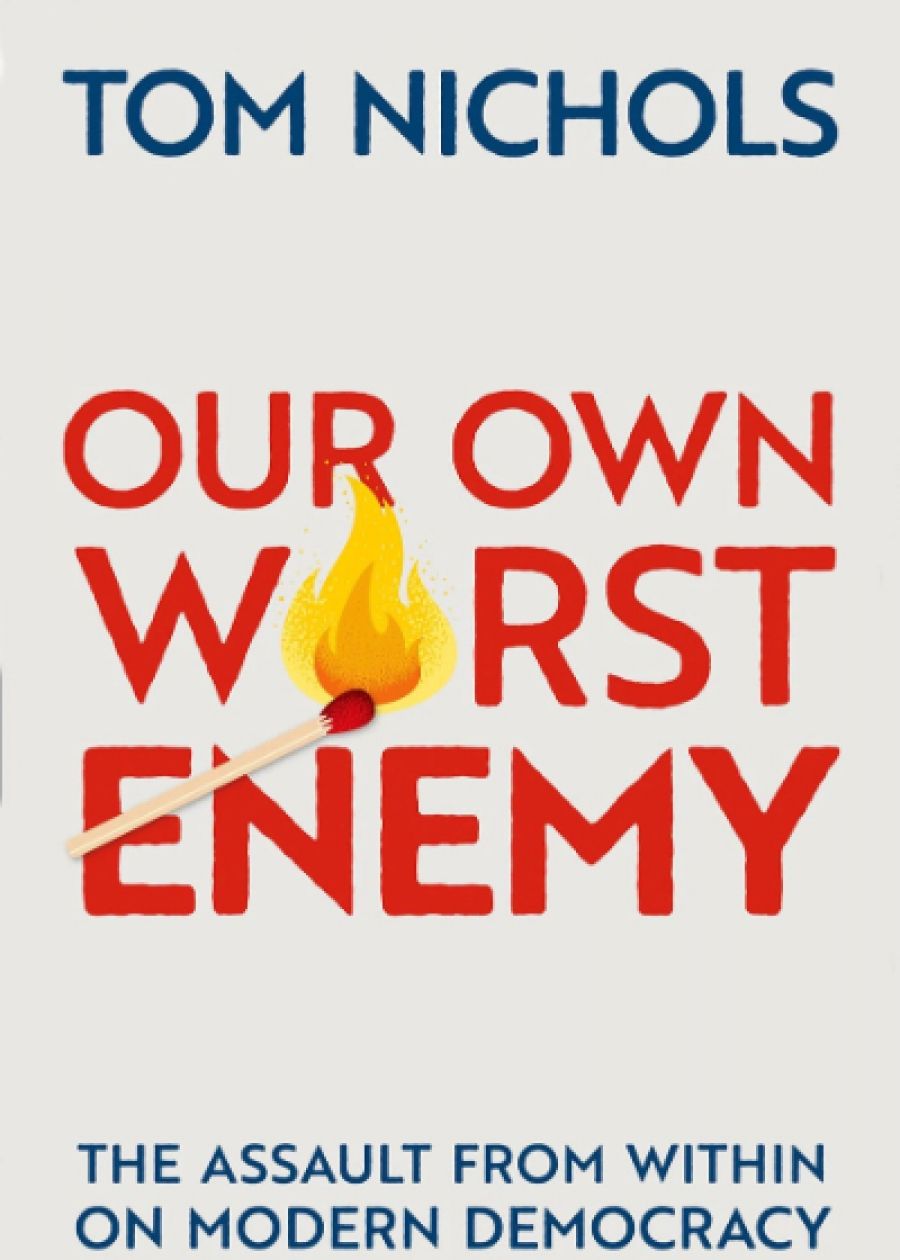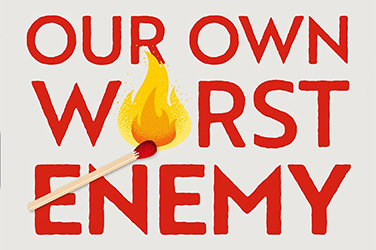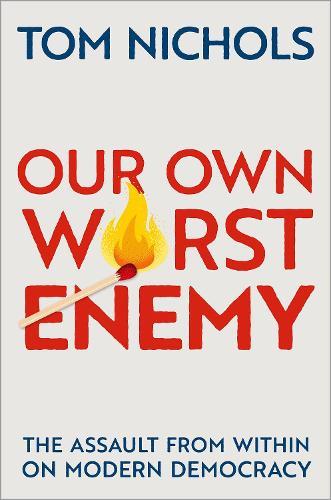
- Free Article: No
- Contents Category: Politics
- Review Article: Yes
- Article Title: Doomscrolling
- Article Subtitle: The long road to civil disobedience
- Online Only: No
- Custom Highlight Text:
The reverberations from 6 January 2021 continue. On that day, two thousand or more protesters stormed the Capitol Building in Washington, DC, intending to overturn the formal ballot electing Joe Biden as president of the United States. Waving phones, livestreaming their moves, some called for the execution of politicians, notably Vice President Mike Pence and Speaker Nancy Pelosi. For the first time, a Confederate flag was waved on the floor of the Congress, while a man wearing horns and waving a ‘Q sent me’ sign became the global image of the invasion. The mob was eventually pushed out of the building, but five people died during or after the assault, and four police officers caught in the mêlée later suicided.
- Article Hero Image (920px wide):
_(retouched)%20copy.jpg)
- Article Hero Image Caption: Outside the Capitol Building in Washington, DC, on 6 January 2021 (Wikimedia Commons)
- Alt Tag (Article Hero Image): Outside the Capitol Building in Washington, DC, on 6 January 2021 (Wikimedia Commons)
- Featured Image (400px * 250px):

- Alt Tag (Featured Image): Glyn Davis reviews 'Our Own Worst Enemy: The assault from within on modern democracy' by Tom Nichols
- Book 1 Title: Our Own Worst Enemy
- Book 1 Subtitle: The assault from within on modern democracy
- Book 1 Biblio: Oxford University Press, £18.99 hb, 256 pp
- Book 1 Cover Small (400 x 600):

- Book 1 Cover (800 x 1200):

Hundreds of protesters were soon picked up by the FBI, swift identification assisted by all those social media posts. ‘Why are they arresting the patriots?’ demanded some puzzled participants, pointing out the president of the United States had encouraged them to ‘fight like hell’ when addressing the crowd. The man with the horns, Jake Angeli, is now serving a three-and-a-half-year sentence, after pleading guilty to violent illegal entry.
The aftermath has sparked many reflections – and some fierce defences. In February 2022, the Republican National Committee described the attack as ‘legitimate political discourse’ and censored two Republican lawmakers who dispute President Donald Trump’s claim of electoral fraud. Politico reports that more than fifty Capitol Hill rioters will stand for office in forthcoming US elections.
Tom Nichols is among the Americans who despair over events at the Capitol. A popular columnist for The Atlantic, and an academic who specialises in military strategy, Nichols is also a former Republican staffer, driven from his party by its embrace of Donald Trump. Our Own Worst Enemy is his analysis of the long road to civil disobedience in the name of overturning a national election.
Worrying whether America is a failed state is fast becoming a profession – and a crowded one at that. Fellow contributor at The Atlantic Yoni Appelbaum has already enumerated potential explanations for the assault on democracy: from discontent over globalisation and automation to inequality, racial tensions, social media, and demographic change. As in Murder on the Orient Express, concludes Appelbaum, ‘every suspect has had a hand in the crime’.
Nichols expands this list of the guilty. His title, Our Own Worst Enemy, references a famous speech by Abraham Lincoln in 1838, claiming that the United States was already so strong that all the armies of the world combined could not invade its shores. Should American democracy falter, prophesied Lincoln, the danger would not come from abroad. ‘If destruction be our lot’, he said, ‘we must ourselves be its author and finisher.’
Nichols shares Lincoln’s fundamental commitment to democracy and understands that self-rule requires endless attention, introspection, and participation. Democracy is a hard taskmaster, asking much of citizens. Our Own Worst Enemy traces trends in contemporary American life undermining the republic – the attacks on expertise, the refusal to compromise or negotiate, a lack of civic engagement, falling trust in institutions, self-pity among the privileged, and the rise of narcissism.
Nichols focuses on cultural rather than economic or international causes for the decline of the American polity. He rejects assertions that globalisation and job losses are the core problem, citing rising living standards and unparalleled national prosperity – ‘it’s not the economy stupid.’ Instead, Nichols explains how first cable television, and now social media, fuel rage and resentment. He laments the absence of public spaces to support reasoned debate, the diminished stock of social capital. Endless connections through our screens, Nichols concludes, make people angry, isolated and selfish, easy to manipulate. We hunger for apocalypse to give us meaning. Citizens spend their time doomscrolling, a practice which feeds constant panic. The devil lives in our phones.
Chapter after chapter details this cultural assault on democratic norms, admirably supported with citation and data. The result is engaging but not quite enough to convince. The author recognises this, apologising several times that he can see the problems but not all the answers. Some comparative analysis might help. For though the focus is the United States, there is little distinctively American about the trends Nichols describes. Social media are ubiquitous, and many nations grapple with inequality, resentment against élites, racial discrimination, and economic insecurity. Democracy has challenges everywhere, but mobs seizing the legislature remain, fortunately, rare. Beyond the occasional mention of Hungary and Turkey, the absence of a global dimension leaves the reader unsure why outcomes are different in the United States.
Nor, beyond a well-crafted passage on Pericles and democracy, does the text examine historical precedents. The long-term loss of faith in politics, suggests Nichols in passing, began in the 1970s with the decline of heavy industry. Suddenly other nations, often helped by US aid, could compete. For that generation of Americans, shaped by the exceptional historical circumstances of 1945, anything less than US hegemony feels like decline.
Yet the world has seen the eclipse of earlier dominant powers. The American republic draws heavily on the Roman republic for its symbols and guiding rationale – a separation of powers to prevent tyranny, limits on the terms of leaders, even minimum age requirements for office. The new nation named the seat of its legislature The Capitol, a conscious nod to the Capitoline Hill at the centre of the Roman republic.
But why model American institutions on a Roman republic that eventually failed, replaced by autocrats and family dynasties? Tacitus described republican government as ‘fragile and evanescent’, easy to admire but difficult to practise. He noted a view that Rome became too big and complex to rule itself through republican conventions. Rules developed for a small city state struggled with empire. Once it conquered the Mediterranean, ploughing enemy cities into the ground, Rome was left with little to unite its elites. Factions fell upon each other for power and spoils.
The Americans who wrote the US constitution embraced Roman concepts of shared power, balanced institutions, and multiple points of veto to constrain power, but added mechanisms so that their constitution could adapt and change. The resulting document has operated without break since 1789, an impressive record of enduring commitment. Amendment, though, has proved difficult, with only twenty-seven amendments, the most recent in 1992. This leaves in place arrangements such as the electoral college, designed to protect the interests of smaller states. In 2000, Al Gore won the popular vote but was denied the presidency. In 2016, the electoral college made Donald Trump president, though Hillary Clinton secured substantially more votes.
Such outcomes undermine trust in a constitution which provides few protections for the core principles of democracy, from majority rule to fair electoral boundaries. The Roman republic fell when ambitious men cynically manipulated existing institutions and blocked reform, sometimes killing those advocating more democratic norms. They created mobs to threaten legislators, propagandists to argue their case, and private armies in case persuasion failed. Within three generations, Rome went from functioning republic to permanent dictatorship, maintaining the façade of representative institutions as a nostalgic nod to an earlier time.
Our Own Worst Enemy asks whether similar pressures erode America from within. Tom Nichols brings impressive breadth to the subject and finishes with a case for three urgent reforms to modernise the American polity. He proposes stronger political parties to better represent the entire American people, a form of civic conscription to recreate a culture of obligation in young people, and constitutional reforms to increase the size of the US House of Representatives and to address rampant gerrymandering. Nichols also encourages citizens to turn off Facebook, citing a study which shows that even a month offline improves mood and happiness in those willing to try.
Even these modest reforms, concedes Tom Nichols, seem unlikely amid the extreme polarisation of contemporary America. If democracy is further undermined by social media, and if the next would-be authoritarian leader is more skilled than Donald Trump, concludes Our Own Worst Enemy, American democracy may perish. Abraham Lincoln, as so often, will have foreshadowed the path for the nation he called ‘the last best hope of earth’.


Comments powered by CComment